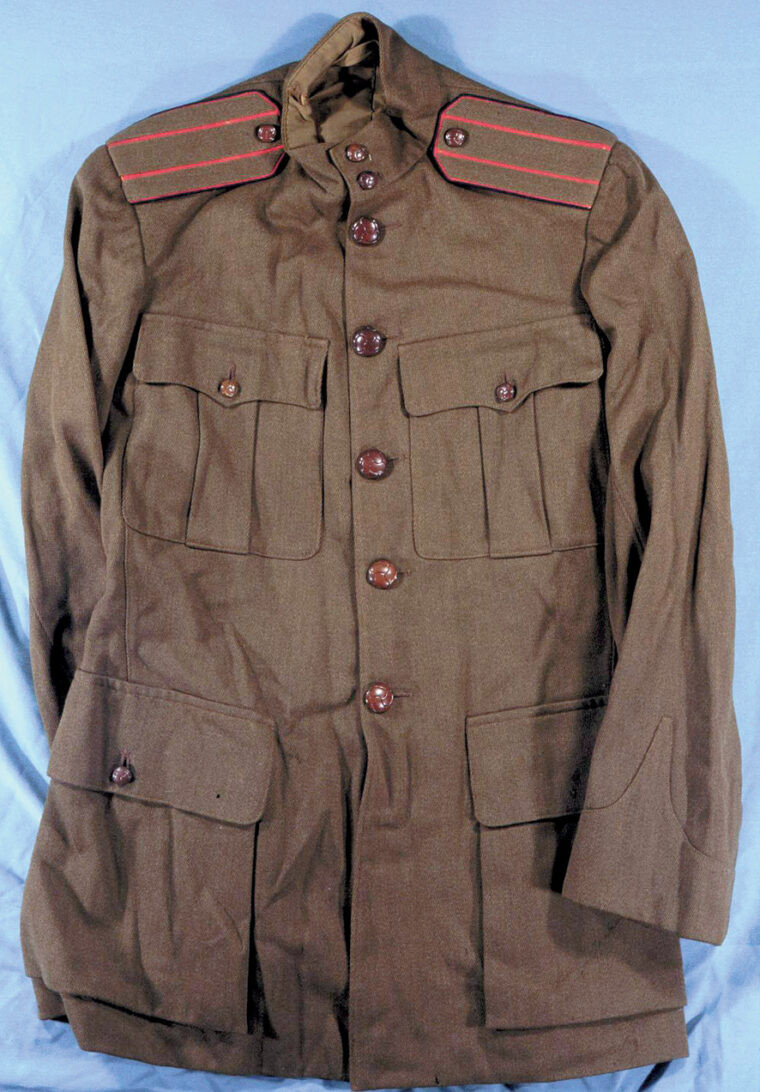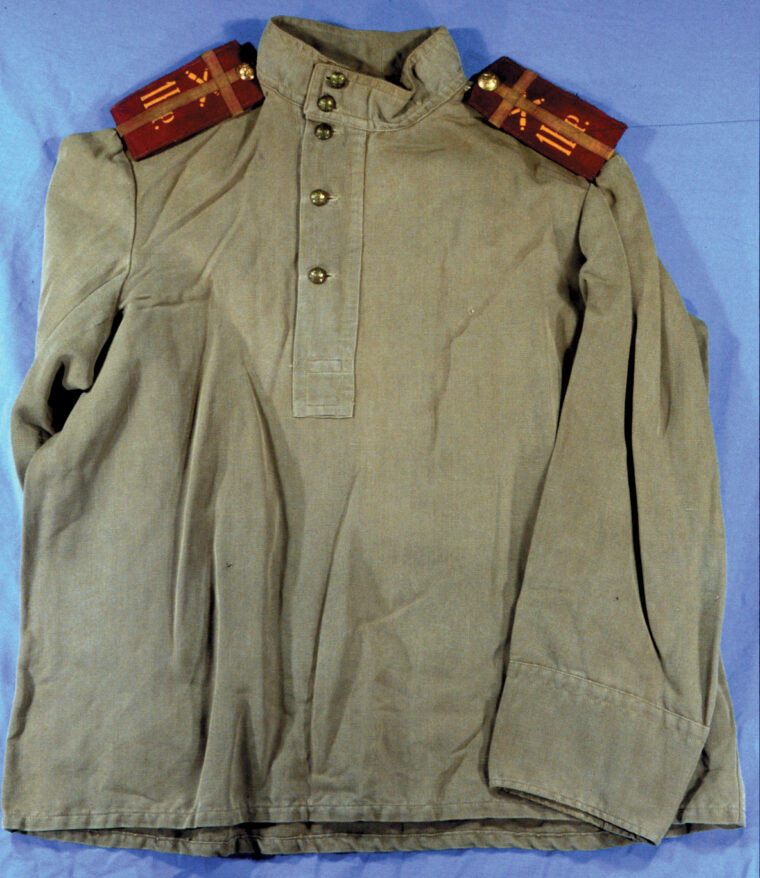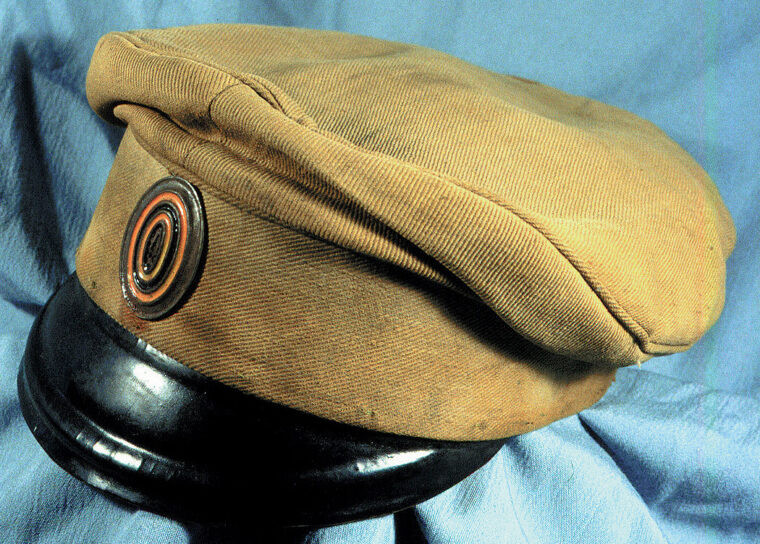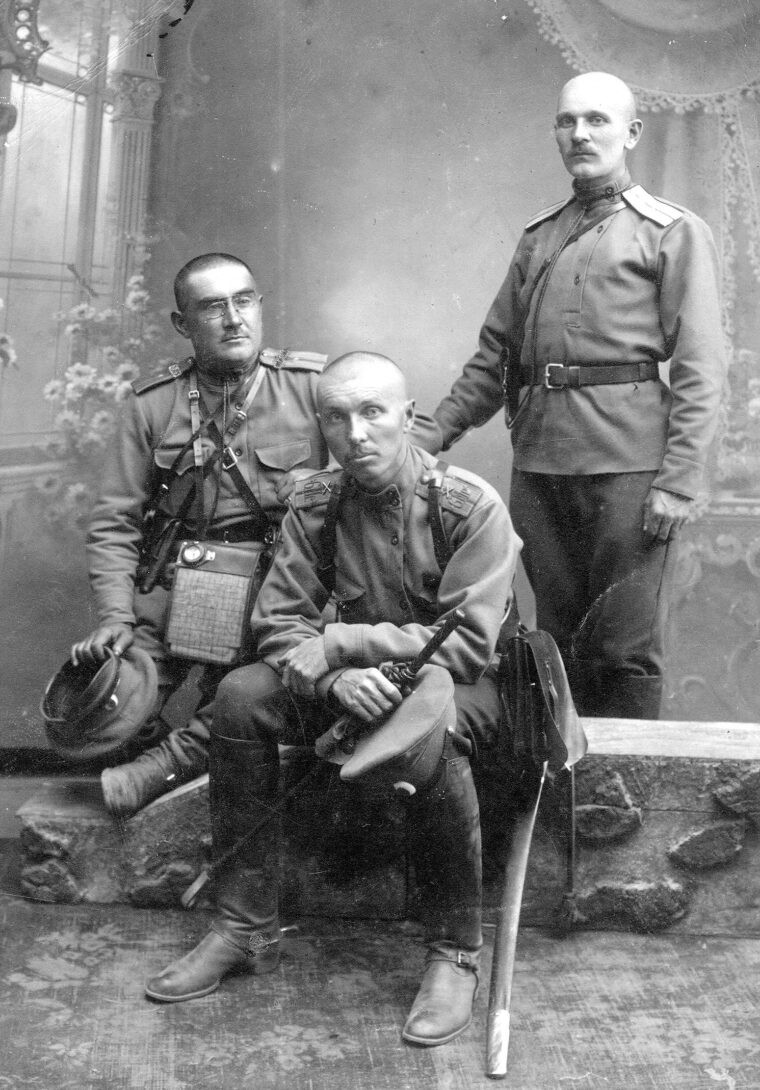The uniforms of the Imperial Russian Army during World War I offer a fascinating glimpse into the logistical challenges and diverse appearances of a military force on the brink of revolution. Often overshadowed by their Western counterparts, Ww1 Russian Uniforms present a unique study for military historians and collectors alike. This article delves into the intricacies of these uniforms, exploring their evolution, variations, and the stories they tell about the Czarist army.
Prior to the Great War, the Russian military recognized the need for modernized field attire following their experiences in the Russo-Japanese War. In 1907, a khaki field uniform was introduced, designed to provide a degree of camouflage compared to the previously used, more conspicuous uniforms. This initial design featured a service coat, known as a kitel, for enlisted men. It was characterized by a stand collar, a five-button front, and two lower pockets. Officers wore a similar kitel, but distinguished by the addition of two breast pockets, setting them apart within the ranks.
Branch-of-service piping was a key identifier on officer’s tunics, adorning both the collar and cuffs. Cavalry officers had a distinctive inverted “v” cuff, while most other officers sported a straight cuff. Interestingly, the pre-war khaki color of these WW1 Russian uniforms, despite being documented as khaki, leaned more towards a green-gray hue. The quality of materials also differed by rank. Officers typically had tailor-made tunics from superior fabric, whereas enlisted men’s uniforms, while of decent quality, used less refined materials. It’s worth noting that even these enlisted uniforms were considered better quality than the fabrics that would be used in later Soviet-era uniforms.
In 1912, a significant addition to the WW1 Russian uniforms was the introduction of the gimnastorka, a field shirt intended for all ranks. This garment, available in wool for winter and cotton for summer, drew inspiration from traditional Russian peasant shirts. The gimnastorka featured a stand collar and a placket with two or three buttons placed either centrally or to the left of the chest. Typically unlined, these shirts became a staple of the Russian soldier’s attire.
 A Russian cavalry colonel’s “French” style field tunic made during WWI with wool cloth imported from England.
A Russian cavalry colonel’s “French” style field tunic made during WWI with wool cloth imported from England.
Alt text: Detailed view of a World War 1 Russian cavalry colonel’s field tunic in the French style, crafted from English wool, showcasing the variations in Imperial Russian Army uniforms.
Officer’s gimnastorkas included two breast pockets with flaps. Although breast pockets were officially authorized for enlisted ranks in 1913, widespread issue during the war seems inconsistent. Button variations were also common, ranging from metal buttons featuring the Imperial Russian Army’s double-headed eagle to more basic bone or even wooden buttons.
The gimnastorka, in particular, became a symbol of the variability of WW1 Russian uniforms. Unlike the standardized mass production seen in the German and British armies, Russian uniforms of this era lacked strict uniformity. While official patterns existed, practical execution often deviated significantly. Placket buttons on gimnastorkas could number two or three, collar closures varied between one and two buttons, and cuff styles ranged from simple to two-button designs. Color variations were also prominent, with khaki shades spanning from brown to light tan, green, and gray. Pockets could be patch or internal, sometimes with flaps. Later in the war, some officers adopted gimnastorkas with four pockets, mirroring the style of their tunics, further blurring the lines of standardization within WW1 Russian uniforms.
Officer tunics themselves were not immune to stylistic variations. Differences arose in pocket styles, button types, and other details. The pre-war kitel style continued to be produced in khaki, but with numerous variations in cuffs, pockets, and collars, contributing to the diverse landscape of WW1 Russian uniforms.
One of the most notable wartime developments was the adoption of the “French” style field tunic. Named after General French, commander of the British Expeditionary Force, this tunic was inspired by the British officer’s field tunic. Characterized by a cotton lining and significantly larger pockets, sometimes with pleats, it represented a departure from pre-war designs within WW1 Russian uniforms. Button choices for the “French” tunic were diverse, including standard-size buttons, bone, wood, leather, or the standard brass double-headed eagle. Extra-large plain buttons were also a popular choice for this style. Typically, these tunics were produced in the same varied khaki shades seen in gimnastorkas, adding to the overall visual diversity of WW1 Russian uniforms.
 An Imperial Russian enlisted rank’s summer gimnastorka. BELOW: An enlisted rank’s summer field cap with cockade in national colors.
An Imperial Russian enlisted rank’s summer gimnastorka. BELOW: An enlisted rank’s summer field cap with cockade in national colors.
Alt text: Image showcasing a World War One Russian enlisted soldier’s summer gimnastorka alongside a summer field cap with the distinctive cockade in national colors, illustrating typical WW1 Russian uniforms.
The significant variations in detail and color within WW1 Russian uniforms can largely be attributed to the strained Russian supply system at the war’s outset. Expecting a short conflict, initial planning did not account for the massive scale of supplies needed for a prolonged war. Russian industry struggled to keep pace, with many suppliers being smaller businesses spread across the vast Russian Empire. This decentralized manufacturing, even when acting as subcontractors for larger military suppliers, resulted in inconsistent adherence to official uniform patterns. This logistical complexity played a major role in the diverse nature of WW1 Russian uniforms observed throughout the war.
This lack of standardization extended beyond tunics and shirts to other essential uniform components like breeches and straight-leg trousers worn by both officers and enlisted men as part of WW1 Russian uniforms. Officer’s trousers featured two stripes of branch piping along the outer seam, a distinction absent from enlisted men’s trousers. While khaki in varying shades was the officially authorized color, dark-blue breeches, originally intended for peacetime wear, also saw wartime use, further contributing to the variations in WW1 Russian uniforms.
Headwear for WW1 Russian uniforms consisted of a field cap made from wool or cotton, featuring a medium-height crown and a leather or composite visor in black or khaki. Officers and some enlisted ranks wore a matching chinstrap. The cap fabric matched the uniform material. A reinforcing ring inside the crown, common before the war, was often removed in the field. Caps were lined with polished cotton, and sweatbands were made of leather or leatherette.
Shoulder straps were a defining feature of WW1 Russian uniforms, used by both enlisted men and officers to display rank and unit affiliation. While the Russian rank system was complex, officer ranks were indicated by metallic braid straps: gold for combat arms and silver for technical and support troops. Regimental or branch-of-service piping was incorporated around and within the braid. Company-grade officers added stars to denote higher rank, which were then removed for field-grade officers up to colonel. Generals wore solid metallic braid straps on their WW1 Russian uniforms.
Enlisted men’s shoulder straps, part of WW1 Russian uniforms, were initially issued in regimental or branch-of-service colors, some being double-sided with khaki reverses. Warrant officers and non-commissioned officers used braid strips in various configurations to indicate their status.
 An enlisted rank’s summer field cap with cockade in national colors.
An enlisted rank’s summer field cap with cockade in national colors.
Alt text: Close-up of a World War 1 Russian enlisted man’s summer field cap, highlighting the cockade in national colors, a key element of WW1 Russian uniforms headwear.
Unit identification was displayed on all ranks’ shoulder straps of WW1 Russian uniforms through numbers or ciphers representing the regiment, battery, or unit. These ciphers often used Cyrillic letters, the first letter of the unit’s name. Officers’ ciphers were metal, while enlisted men’s were typically painted onto the straps.
After the war’s outbreak in 1914, shoulder straps for WW1 Russian uniforms were mandated to be khaki for both officers and enlisted men, eliminating branch-of-service colors, though unit ciphers and numbers persisted. However, consistent with other uniform items, no single standard manufacturing method existed for shoulder straps, leading to a wide array of original styles seen in WW1 Russian uniforms.
Beyond shoulder straps, another iconic element of WW1 Russian uniforms was footwear: the black leather boots synonymous with the 20th-century Russian soldier. However, the Russian army’s logistical shortcomings at the start of WWI again became apparent with boot shortages. Insufficient boots were available for the millions mobilized in 1914, mirroring shortages of rifles and uniforms. Millions of pairs of boots had to be imported from the United States to address this crucial deficiency in WW1 Russian uniforms and equipment.
Importing war supplies, including boots and even khaki cloth from Great Britain (used for officer’s wool gabardine tunics mirroring British officer’s uniforms), became critical to the Russian war effort. Leather shortages also impacted the availability of basic field equipment for WW1 Russian uniforms.
Enlisted men’s field kit for WW1 Russian uniforms typically included a brown leather belt with a wire or brass buckle holding two cartridge pouches. A topless brass mess kit (more like a pot) hung from the belt, along with a haversack, canteen, and a small shovel in a brown leather carrier. The overcoat, when not worn, was rolled and carried over the shoulder. Officers carried a belt with shoulder straps, a sword, canteen, map case, and pistol, but were generally not burdened with much additional equipment as part of their WW1 Russian uniforms.
 A group of artillery officers dressed for the field with typical field equipment, circa 1915. The man at right is wearing an enlisted style gimnastorka.
A group of artillery officers dressed for the field with typical field equipment, circa 1915. The man at right is wearing an enlisted style gimnastorka.
Alt text: A photograph from circa 1915 depicting a group of Russian artillery officers in field dress, showcasing typical field equipment and variations in WW1 Russian uniforms, including an enlisted style gimnastorka worn by an officer on the right.
Like uniforms, field equipment associated with WW1 Russian uniforms exhibited variations based on manufacturer. These inconsistencies, while historically interesting, pose challenges for collectors seeking authentic pieces, as a definitive benchmark pattern is often lacking for WW1 Russian uniforms and equipment.
Further complicating collecting efforts are reproductions, some originating from Soviet film studios, that have entered the market. However, these copies often use thinner, less substantial wool or cotton compared to original WW1 Russian uniforms. Interestingly, the presence of a Russian film studio stamp doesn’t automatically disqualify an item as original, as studios were sometimes sources of original uniforms. As with any collecting pursuit, familiarity with genuine WW1 Russian uniforms and meticulous attention to manufacturing details remain the best tools for verifying authenticity.
Imperial Russian uniforms, a tangible piece of history, have always been relatively scarce, even within Russia. The majority of the millions of WW1 Russian uniforms produced before 1917 were simply worn out during years of service. Paradoxically, Russian émigré communities established after the Russian Revolution have often proven to be a more fruitful source of these historical artifacts than Russia itself.
Finding original WW1 Russian uniform items can be challenging yet rewarding. These pieces occasionally surface in unexpected places. A gimnastorka or cap can command prices exceeding $350, while an officer’s tunic can fetch over $500, reflecting their rarity and historical significance.
Specialized militaria dealers focusing on World War I items, along with antique dealers specializing in Imperial Russian artifacts, are the most likely sources for purchasing WW1 Russian uniforms. Online auctions also occasionally feature items, often accompanied by images to aid potential buyers. Regardless of the purchase venue, direct examination or a money-back guarantee is advisable when acquiring rare and historically significant items like Imperial Russian militaria and WW1 Russian uniforms.
In conclusion, WW1 Russian uniforms present a compelling study in military attire, highlighting the blend of pre-war regulations, wartime adaptations, and the impact of logistical realities on the appearance of an army in the field. Their variations and unique characteristics make them a fascinating area of interest for historians and collectors, offering a tangible connection to the tumultuous era of World War I and the twilight of Imperial Russia.
